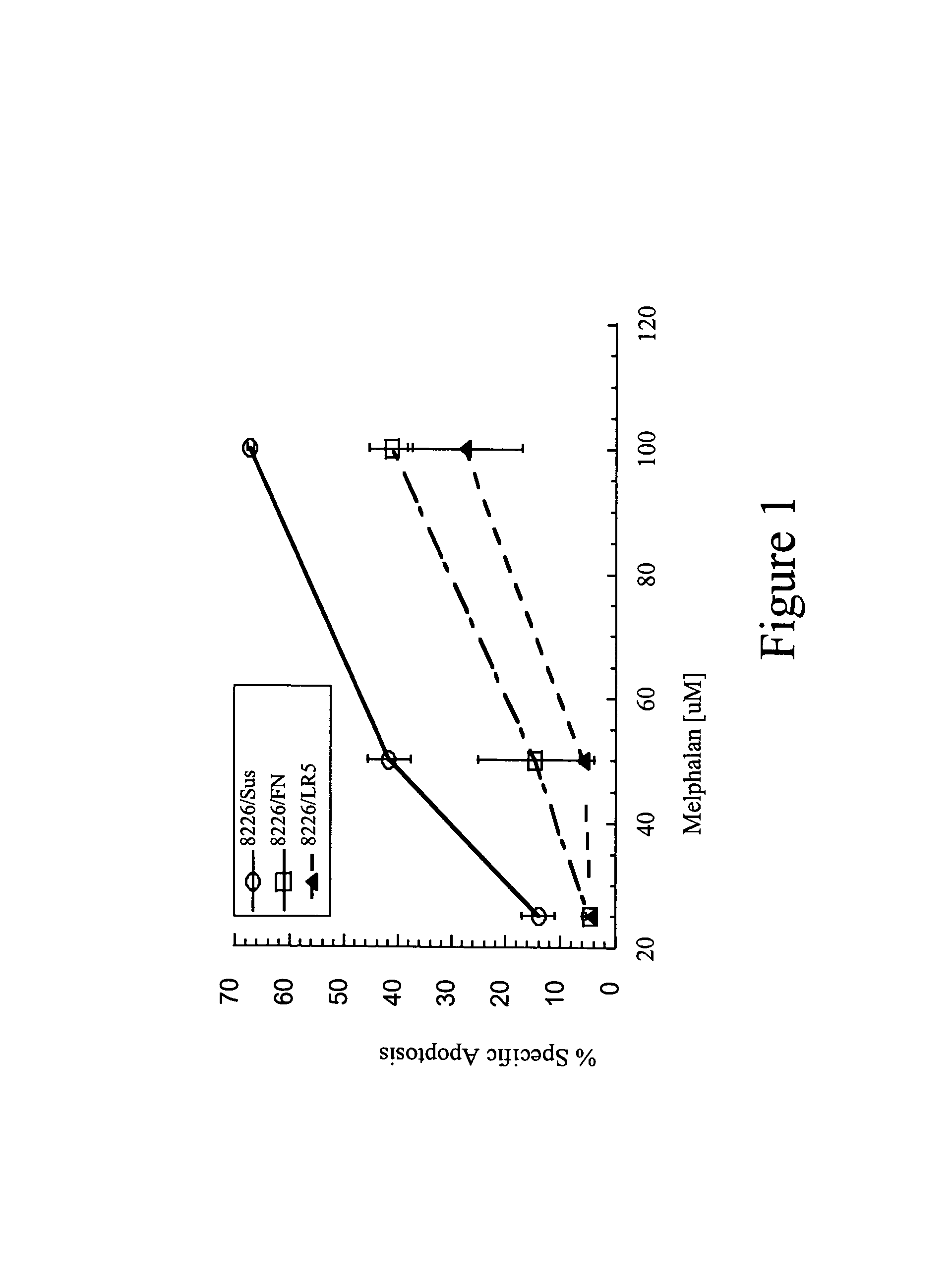Materials and methods for treating oncological disorders
a technology for oncological disorders and materials, applied in the field of materials and methods for treating oncological disorders, can solve the problems of drug resistance, patients will acquire drug resistance, and are not known if drug resistance mechanisms are identified, so as to prevent or reduce the development of cancer cells, inhibit cholesterol synthesis, and prevent or reduce the effect of cholesterol synthesis
- Summary
- Abstract
- Description
- Claims
- Application Information
AI Technical Summary
Benefits of technology
Problems solved by technology
Method used
Image
Examples
example 1
Adhesion of the 8226 Myeloma Cell Line to FN Inhibits Melphalan-Induced Apoptosis
[0070]Annexin V positivity was used to detect apoptotic cells following melphalan treatment of either the parental RPMI 8226 myeloma cell line (8226 / Sus), the parental 8226 cell line adhered to FN (8226 / FN) and the melphalan-selected 8226 cell line in suspension (8226 / LR5). These experiments allowed for comparing resistance levels associated with de novo and acquired resistance in a isogenic model system. As depicted in FIG. 1, the parental 8226 cell line adhered to FN and the drug resistant variant 8226 / LR5 cell line are both significantly resistant (p<0.05 at each dose tested Student's t-Test n=9 per group) to melphalan induced cell death compared to the parental 8226 cell line maintained in suspension media (8226 / Sus). These data show that adhered cells and cells with acquired melphalan resistance are similarly protected from melphalan induced apoptosis.
example 2
Adhesion of Myeloma Cells From Patient Specimens to FN Inhibits Melphalan Induced Apoptosis
[0071]In order to determine whether the CAM-DR phenotype is a potential mechanism of clinical de novo drug resistance, melphalan induced cell death was measured in primary patient specimens. Plasma cells were identified by either positive kappa or lambda staining, and apoptotic myeloma cells were identified by the Tunel assay (FIG. 2A). Nine out of 10 patient specimens were protected from melphalan induced cell death when attached to FN (FIG. 2B). The mean percent apoptosis of plasma cells obtained from bone marrow aspirates and adhered to FN prior to treatment with 200 uM melphalan was 27.7% (95% LCI 17.6 and 95% UCI=32.8) compared to 55.6% (95% LCI=44.1% and UCI=67.2%) apoptosis for plasma cells maintained in cell suspension (p<0.05, Students paired t-test). These data further support the role of FN-mediated adhesion in mediating clinical de novo drug resistance.
example 3
DNA Crosslinks are Reduced in Acquired Drug Resistant Cells but not Adherent Cells
[0072]It has previously been reported, using the alkaline elution assay, that melphalan resistance in the acquired drug resistant cell line (8226 / LR5), correlated with reduced DNA crosslinks (Bellamy et al., 1991). An alkaline comet assay was used to determine if cellular adhesion also reduced the amount of melphalan induced DNA-crosslinks. The comet assay indicated that melphalan induced crosslinks were significantly reduced in the drug-selected 8226 / LR5 cell line (FIG. 3A, ANOVA p0.05) compared to 8226 cells treated in suspension (FIG. 3B). These data show that anti-apoptotic target(s) associated with resistance in FN adhered cells reside downstream of the formation of melphalan induced DNA crosslinks.
PUM
| Property | Measurement | Unit |
|---|---|---|
| Electrical resistance | aaaaa | aaaaa |
| Cell adhesion | aaaaa | aaaaa |
Abstract
Description
Claims
Application Information
 Login to View More
Login to View More - R&D
- Intellectual Property
- Life Sciences
- Materials
- Tech Scout
- Unparalleled Data Quality
- Higher Quality Content
- 60% Fewer Hallucinations
Browse by: Latest US Patents, China's latest patents, Technical Efficacy Thesaurus, Application Domain, Technology Topic, Popular Technical Reports.
© 2025 PatSnap. All rights reserved.Legal|Privacy policy|Modern Slavery Act Transparency Statement|Sitemap|About US| Contact US: help@patsnap.com



